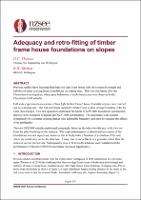| dc.contributor.author | Thomas, Geoff | |
| dc.contributor.author | Shelton, Roger | |
| dc.date.accessioned | 2021-06-22T04:02:03Z | |
| dc.date.available | 2021-06-22T04:02:03Z | |
| dc.date.issued | 2021-04-14 | |
| dc.identifier.uri | https://repo.nzsee.org.nz/xmlui/handle/nzsee/2411 | |
| dc.description.abstract | Previous studies have indicated that there are significant issues with the structural strength and stability of many existing house foundations on sloping sites. This was confirmed after the Christchurch earthquakes, where poor behaviour of such foundations was observed in the Christchurch hill suburbs.
Full scale experiments on a series of four light timber framed house foundation types, were carried out on a sloping site. The test specimens included a timber floor system of approximately 2.4m by 4.8m (downslope). Two test specimens replicated the limits of NZS 3604 foundation construction and two were examples of typical pre-NZS 3604 construction. The specimens were excited dynamically by a counter-rotating shaker with adjustable frequency and mass to simulate the effects of an earthquake.
The two NZS3604 samples performed adequately, however the other two did not, with wire ties from the piles breaking in one instance. The expected progressive downward movement of the foundations was not significant, however this is likely to be a function of excitation of the soil, where we could only excite the structure. It may also be more likely in a granular, rather than the cohesive soil on the test site. Subsequently easy to fit retro-fit solutions were installed and the performance of the pre-NZS3604 specimens increased significantly. | |
| dc.language.iso | en | |
| dc.publisher | New Zealand Society for Earthquake Engineering | |
| dc.relation.ispartofseries | 2021;0181 | |
| dc.subject | Advancements in structural and geotechnical design and assessment | |
| dc.title | Adequacy and Retro-Fitting of Timber Frame House Foundations on Slopes | |
| dc.type | Article | |

